More than 57% of SMBs expanding globally rely on toll-free numbers to handle inbound customer calls. But most don’t realize those numbers often stop working the moment their customers cross a border.
Take this scenario: A business based in New York lists a standard US 800 number as its main customer support line. A client in France dials the same number, only to hear a dead tone. No connection. No fallback. Just silence. That same “toll-free” number simply doesn’t work outside the U.S., even though it looks global on paper.
It’s a common mistake, especially for businesses scaling into new markets without a deep understanding of telecom infrastructure. Toll-free numbers are never truly international by default. They’re designed to be toll-free within specific national boundaries, often tied directly to the local telecom system that issued them. Once you cross into a different country’s network, those benefits disappear. In most cases, the call doesn’t go through at all. If it does, the caller pays full international rates, negating the very point of the “toll-free” promise.
That misunderstanding leads to broken communication flows, lost leads, and customer frustration, especially in regions where landlines are still dominant or mobile data is unreliable. Before adopting toll-free solutions globally, it’s critical to understand what actually works across borders, and what doesn’t.
Let’s look at why most toll-free numbers fail internationally, and what your business can do to fix it.
Key Takwaways
- No, standard toll-free numbers are not free (or even reachable) from abroad. They’re only toll-free within their country of origin unless explicitly set up for international access.
- International Toll-Free Numbers (ITFNs) solve this by assigning local toll-free lines in each country that route to your global support line, but they come with higher setup, monthly, and per-minute costs.
- For broader, more cost-effective global coverage, consider alternatives like local DIDs, SIP routing, call-back systems, or messaging tools (e.g., WhatsApp or live chat) that scale better in mobile-first or low-infrastructure regions.
Why Domestic Toll-Free Numbers Don’t Work Internationally
The assumption that a toll-free number will function the same across borders breaks down quickly under technical and legal scrutiny. What looks like a simple phone number on the surface is deeply embedded in country-specific routing rules and billing structures. To understand why your domestic toll-free number can’t be reached from abroad, or worse, results in unexpected charges, it’s worth breaking down the two core barriers.
Technical Limitations of Standard Toll-Free Numbers
Toll-free numbers are tied to local telecommunications infrastructure. When someone in the same country dials a toll-free number, their call is routed through the national PSTN (Public Switched Telephone Network) using internal signaling and predefined carrier agreements. Once the call crosses international boundaries, the routing logic changes entirely.
Here’s the issue: most domestic toll-free numbers don’t register correctly with foreign telecom networks. They lack the proper international prefixes and don’t follow standardized signaling protocols that allow recognition across borders. Carriers in the originating country either drop the call entirely or reroute it through default international channels, which are never toll-free.
Billing and Jurisdiction Barriers
Toll-free numbers operate on a reverse billing model: the receiving business pays for the call, not the caller. This system works only when both parties are within the same telecom jurisdiction.
Domestic telecom providers (e.g., AT&T in the U.S., BT in the UK) have contracts in place to cover the cost of incoming toll-free traffic within national borders. The moment a foreign telco, like Vodafone Germany or Airtel India, enters the equation, that billing model collapses. There’s no automatic agreement that says, “this French carrier will waive charges and bill the American company instead.”
Even if the call connects, the caller usually ends up paying international rates, because the foreign network has no billing relationship with the recipient’s toll-free provider.
Telecom regulatory bodies reflect this fragmentation:
- FCC (US): Manages domestic toll-free frameworks, no oversight of international access
- Ofcom (UK): Defines freephone access for UK residents, but doesn’t enforce international toll-free availability
- ITU (International Telecommunication Union): Offers UIFN standards, but adoption is limited and inconsistent across markets
Without harmonized global rules, and without carriers agreeing on who pays for what, standard toll-free models fall apart the moment they go cross-border.
The Real Solution: International Toll-Free Numbers (ITFNs)
While standard toll-free numbers fail to deliver true global accessibility, there’s a more specialized option built for cross-border communication: International Toll-Free Numbers (ITFNs). These are designed specifically to let customers in one country reach a business in another, without being charged. But not all ITFNs are created equal, and they come with their own structural nuances.
What Are ITFNs and How Do They Work?
An ITFN is a country-specific number that looks and functions like a toll-free line within the caller’s country. But behind the scenes, the call routes internationally to your business, typically landing on a central line, VoIP system, or PBX.
From the caller’s perspective, it’s just a free call to a familiar prefix (like 0800 in the UK or 1-800 in the U.S.). They never see the international destination. All charges are absorbed by the receiving business, including the cost of international routing.
Here’s what happens technically:
- The customer dials a toll-free number assigned to their country.
- That number maps to your real business line, wherever it sits in the world.
- The local carrier hands off the call to an international partner.
- You pay for every minute of that connection.
This setup preserves the “free for the caller” experience, while allowing centralized global support without maintaining physical offices in every region.
UIFNs vs Country-Specific ITFNs
There are two primary ways to set up toll-free access across multiple countries: Universal International Freephone Numbers (UIFNs) and individual ITFNs per country.
| Feature | UIFNs (+800) | Country-Specific ITFNs |
| Prefix Format | +800 | Varies by country (e.g., 0800, 1-800) |
| Coverage | 60+ countries (limited adoption) | Any country with telecom agreements |
| Caller Experience | One unified number | Local toll-free number for each market |
| Setup Time | 3–6 weeks (ITU approval required) | 1–3 weeks (faster provisioning) |
| Pros | Brand consistency, single number | More reliable, broader access |
| Cons | Doesn’t work in many countries or mobiles | Requires one number per country |
UIFNs offer a consistent +800 number across borders, but availability is inconsistent. Countries like Japan, Brazil, and even parts of the EU either don’t support them or only partially do, especially when mobile phones are involved.
Carrier-specific ITFNs, by contrast, give you a separate toll-free number per country. It’s more overhead, but it guarantees better performance, local recognition, and compatibility.
Limitations You Must Know
Even the most sophisticated toll-free setup doesn’t guarantee universal reach. Several countries impose restrictions that limit how ITFNs or UIFNs behave.
Mobile access is the biggest blocker. In countries like Brazil and India, toll-free numbers often incur mobile surcharges or are outright blocked on mobile networks, despite working from landlines. That’s a major issue in regions where mobile usage dominates.
Examples:
- Brazil: Many carriers charge extra for 0800 calls from mobile devices—or block access altogether.
- India: Some ITFNs are only reachable from select regions, and mobile coverage is inconsistent.
- China: Toll-free numbers often fail to connect from mobile networks unless configured through local Tier-1 carriers.
Also, certain countries require local business registration to activate toll-free service. Without that paperwork, you may not even be allowed to provision a number, regardless of how much you’re willing to pay.
Real Costs of International Toll-Free Numbers
ITFNs solve the problem of accessibility, but they do it at a price. Businesses often underestimate how much this solution actually costs to set up and maintain. And since each country has its own pricing model, the total expense can scale quickly if not carefully planned. Let’s break down the costs and when investing in this model makes sense.
Cost Breakdown: Setup, Monthly, Per-Minute
International toll-free numbers come with three core charges:
- One-time setup fee
- Monthly recurring fee
- Per-minute call rates
The actual price depends heavily on the country, network quality, and whether mobile coverage is included. Below is a snapshot of typical costs in high-demand markets, based on publicly available telecom pricing as of mid-2025:
| Country | Setup Fee | Monthly Fee | Per-Minute Rate | Mobile Access | Notes |
| United States | $0–$15 | $10–$25 | $0.05–$0.12 | Included | Cheapest market |
| United Kingdom | £10–£20 | £15–£30 | £0.10–£0.22 | Often restricted | Carrier-dependent |
| Australia | $15–$25 | $20–$40 | $0.15–$0.30 | Included | Higher base rate |
| Japan | ¥2,000–¥5,000 | ¥3,000–¥6,000 | ¥30–¥65/min | Landline only | Rural access issues |
| Brazil | $30–$60 | $35–$60 | $0.40–$0.80 | Not reliable | Mobile surcharges common |
| India | ₹1,500–₹3,500 | ₹2,000–₹4,500 | ₹15–₹30/min | Partially available | Regional restrictions |
Additional costs may include:
- Add-ons for mobile routing
- Priority routing or low-latency options
- Regulatory fees in certain countries (especially LATAM & APAC)
For businesses targeting 3–5 countries with high inbound volume, these fees can easily exceed $1,000/month, and that’s before usage charges begin to scale.
When It’s Worth It, and When It Isn’t
ITFNs make financial sense when the business case involves direct revenue impact or high-value user engagement. They’re not a branding gimmick, they’re a utility cost that should return measurable value.
Invest in ITFNs if:
- You’re in fintech, travel, or global SaaS and need frictionless, voice-based support in key regions
- A missed call could result in lost deals, churn, or regulatory problems
- Your business has localized sales or compliance teams handling sensitive conversations
- The brand relies on trust and immediacy, especially for industries like insurance, legal, or healthcare
Avoid ITFNs if:
- You operate in low-touch B2B industries with long sales cycles and infrequent support calls
- Customers prefer async support (chat, email) over live voice
- You’re scaling into new markets and testing demand with limited customer service infrastructure
- You rely heavily on mobile-first countries where toll-free access is unreliable
For many companies, a hybrid model often works best, ITFNs for Tier-1 markets and digital alternatives elsewhere. The key is knowing where your customers actually need to call you and whether they’re willing to use voice at all.
Alternatives That Work (Often Better)
ITFNs are powerful, but they’re not the only way to support global customers. In many cases, businesses can achieve the same (or better) customer experience using smarter, leaner communication tools, especially when targeting mobile-first markets or managing support across time zones. Here’s how alternative setups can replace toll-free numbers without compromising accessibility.
Local DIDs with Global Routing
Instead of paying for expensive international toll-free lines, companies can deploy Direct Inward Dialing (DID) numbers in each target country. These appear as local phone numbers to the customer, but route the call wherever you want, even halfway across the world.
Customers pay standard local rates (or nothing at all, depending on their plan), while the business handles routing using SIP trunking or cloud PBX systems. Providers like DIDlogic allow businesses to spin up virtual numbers in over 160 countries, with instant activation and transparent per-minute rates.
Why it works:
- Customers trust local area codes more than generic +800 lines
- Call quality is often higher due to regional carrier integration
- No need for country-specific toll-free provisioning or mobile exceptions
When combined with a cloud contact center or SIP-based softphone solution, local DIDs can replicate the functionality of ITFNs at a fraction of the cost.
VoIP & Call-Back Features
Voice-over-IP removes the need for a phone number altogether. Many businesses now rely on web-based VoIP tools that let customers initiate a call directly from the website. No dial pad, no carrier fees, just a browser and a microphone.
Other companies offer call-back functionality, where the customer fills out a short form or clicks a “Request a Call” button. The system then dials them back automatically, allowing the business to control call timing, cost, and routing logic.
Options include:
- SIP URIs: Direct SIP links that initiate VoIP calls from desktop apps or softphones
- Click-to-call widgets: Embedded on websites or mobile apps
- Automated call-back systems: Popular in customer service for reducing queue time
Because the business initiates the call, there’s no cost for the customer, preserving the “toll-free” experience without the infrastructure overhead.
Messaging and Chat-Based Support
Voice isn’t always the channel your customers prefer, especially outside North America and Europe. In mobile-first markets, real-time messaging platforms have become the default way to reach businesses.
Examples include:
- WhatsApp Business API: Lets businesses send transactional updates and support responses
- Telegram bots: Allow scripted, interactive experiences for service queries
- Live chat tools: Embedded on websites with smart routing to agents or AI
Unlike toll-free voice, these channels scale across regions instantly. No provisioning. No per-minute costs. And unlike email, they offer the immediacy users expect, without the friction of calling.
For high-growth startups or lean teams, shifting traffic to chat and messaging not only reduces telecom spend but frees up agents to handle more interactions with fewer interruptions.
Regulatory, Technical & Support Considerations
Choosing the right communication setup isn’t just about cost or call quality. International voice infrastructure has to meet the technical, legal, and cultural requirements of every country it touches. Ignoring any one of those can break your customer support model before it even launches. Here’s what to plan for.
Compliance by Country
Telecom regulation varies dramatically from one country to another. In many regions, provisioning an international toll-free number or even a local DID requires documentation, often including proof of business registration, a local tax ID, or a physical address.
For example:
- India often mandates a local presence and detailed verification before number activation.
- China may require license documentation from the Ministry of Industry and Information Technology.
- Germany has strict rules around number usage transparency and data handling.
Failing to meet these requirements can lead to delays, service interruptions, or denied provisioning altogether.
That’s why it’s critical to work with a provider that understands the nuances of each market. DIDlogic, for instance, handles the regulatory legwork for over 160 countries, streamlining documentation and ensuring your setup stays compliant from day one.
Time Zones, Routing Logic & IVRs
Global communication means your customers are calling at all hours, and expecting someone to pick up. Managing time zones without proper routing logic often results in long wait times, missed calls, or agents answering questions outside their domain.
Smart routing architecture solves this:
- Regional IVRs detect where a call is coming from and present local-language options tied to relevant departments.
- Failover routing automatically diverts calls to backup agents or voicemail if primary teams are offline.
- Time-based routing ensures customers reach the right team based on local business hours.
This setup prevents overload and ensures round-the-clock support, without requiring 24/7 staffing in every location.
Language & Localization
Offering a toll-free number or VoIP line in another country creates an immediate expectation: someone on the other end should speak the caller’s language. If they don’t, the experience falls apart fast.
Multilingual support is more than a nice-to-have, it’s fundamental to building trust. Whether you’re handling support in Japan, onboarding clients in Mexico, or selling in the UAE, localization matters at every touchpoint.
Best practices include:
- Hiring native speakers for priority regions
- Using language-aware IVRs to route calls correctly
- Offering call-back forms or web chat in multiple languages
And if live staffing isn’t feasible across all regions, pairing VoIP with AI-assisted translation tools or chatbots can fill in gaps without lowering quality.
Choosing the Right Strategy for Your Global Communication
Not every business needs the same solution. Some require voice-first infrastructure with regulatory compliance across multiple countries. Others need lightweight, scalable support that reaches mobile users with minimal telecom spend. Choosing the right setup means balancing coverage, cost, complexity, and customer expectations.
Below is a simplified breakdown of the most common international communication solutions:
| Solution | Cost | Coverage | Setup Time | Best For |
| ITFN | High | Medium | 1–3 weeks | Enterprise, Call Centers |
| UIFN | High | Low–Medium | 2–4 weeks | Global Branding |
| Local DID | Low | High | Instant | SaaS, Startups |
| Call-Back | Medium | Global | Instant | eCommerce, Support |
| Messaging | Low | High | Instant | Mobile-first markets |
Each model solves a different part of the communication puzzle. Some offer immediate accessibility. Others provide control, brand consistency, or regulatory reach. The most successful global businesses usually blend several of these.
Quick checklist for decision-makers:
- Do you need mobile access in markets like Brazil, India, or China?
- Is 24/7 live voice support necessary, or will async channels suffice?
- Can your team support multiple languages or time zones?
- Are there regulatory requirements tied to your industry or region?
- What’s the maximum monthly budget you can allocate to inbound communication?
Clarifying these questions before provisioning infrastructure will save time, money, and customer frustration.
Final Thoughts: Global Voice Strategy for 2025 and Beyond
Global communication is no longer about finding a single solution, it’s about building a resilient mix that reflects how people actually want to engage with your business.
Toll-free lines still matter in high-touch environments, especially where customer trust hinges on availability. But they’re no longer the default. In 2025, the most effective voice strategies are hybrid by design: combining toll-free coverage in key markets with SIP-routed DIDs, browser-based calling, smart call-back flows, and channel-specific support like WhatsApp or live chat.
Future-proofing means choosing platforms that scale across geographies without forcing trade-offs between compliance, cost, and experience. Providers like DIDlogic give growing companies the infrastructure flexibility to meet customers wherever they are, on their phones, screens, or apps, without building from scratch every time they expand into a new region.
Global voice isn’t about the number. It’s about reach without friction, and knowing exactly where every call, click, or message lands.
FAQs
Can I call a US toll-free number from Canada for free?
Yes. US toll-free numbers are generally free to call from Canada because both countries are part of the North American Numbering Plan (NANP). Most 800, 888, 877, and similar prefixes work seamlessly across both countries without additional charges. Just note that some businesses may restrict access by region or carrier.
Do toll-free numbers work from mobiles abroad?
Not reliably. In many countries, mobile carriers block access to toll-free numbers or apply surcharges, even when the number is meant to be free. Brazil and India are common examples. Always check with your provider whether mobile access is included for each country.
How long does it take to set up an international toll-free number?
Provisioning typically takes 1 to 3 weeks, depending on the country. Some markets require additional business documentation or regulatory approvals, which can extend the timeline, especially in regions like China, India, or Brazil.
Is there a single toll-free number that works globally?
Not exactly. Universal International Freephone Numbers (UIFNs) use the +800 prefix and work in around 60 countries, but not universally, and rarely from mobile phones. Most businesses still need separate ITFNs or local DIDs for full global reach.
What happens if someone calls from an unsupported country?
In most cases, the call fails to connect. The caller may hear a busy tone or a message stating the number isn’t reachable from their location. No charges apply for failed calls, but it creates a poor user experience, so it’s critical to check country-level support in advance.
Further Reading
- Are toll-free numbers still relevant?
- Can toll-free numbers be scams?
- Can toll-free numbers receive SMS?
- Who uses toll-free number pages?
- DID vs toll-free number pages










